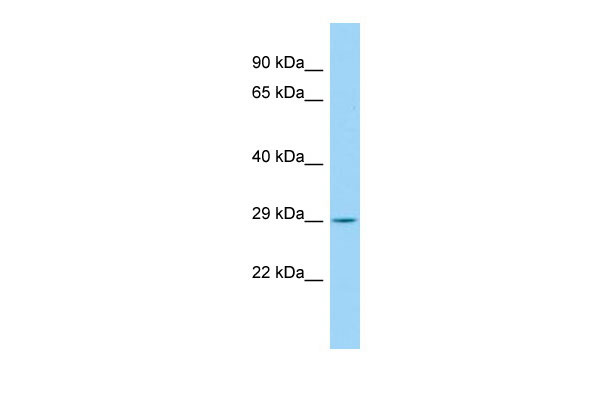CCDC134 Antibody - C-terminal region
Rabbit Polyclonal Antibody
- 产品详情
- 实验流程
Application
| WB |
|---|---|
| Primary Accession | Q9H6E4 |
| Other Accession | NM_024821, NP_079097 |
| Reactivity | Human, Mouse, Rat, Rabbit, Dog, Guinea Pig, Horse, Bovine |
| Predicted | Human, Mouse, Rat, Rabbit, Pig, Dog, Guinea Pig, Horse, Bovine |
| Host | Rabbit |
| Clonality | Polyclonal |
| Calculated MW | 26561 Da |
| Gene ID | 79879 |
|---|---|
| Alias Symbol | FLJ22349, MGC21013, dJ821D11.3 |
| Other Names | Coiled-coil domain-containing protein 134, CCDC134 |
| Format | Liquid. Purified antibody supplied in 1x PBS buffer with 0.09% (w/v) sodium azide and 2% sucrose. |
| Reconstitution & Storage | Add 50 ul of distilled water. Final anti-CCDC134 antibody concentration is 1 mg/ml in PBS buffer with 2% sucrose. For longer periods of storage, store at 20°C. Avoid repeat freeze-thaw cycles. |
| Precautions | CCDC134 Antibody - C-terminal region is for research use only and not for use in diagnostic or therapeutic procedures. |
| Name | CCDC134 {ECO:0000303|PubMed:39509507, ECO:0000312|HGNC:HGNC:26185} |
|---|---|
| Function | Molecular adapter required to prevent protein hyperglycosylation of HSP90B1: during translation, associates with nascent HSP90B1 and the STT3A catalytic component of the OST-A complex and tethers them to a specialized translocon that forms a microenvironment for HSP90B1 folding (PubMed:38670073, PubMed:39509507). In the CCDC134-containing translocon, STT3A associates with the SRT pseudosubstrate motif of HSP90B1, preventing access to facultative glycosylation sites until folding is completed, preventing hyperglycosylation and subsequent degradation of HSP90B1 (PubMed:39509507). In extracellular secreted form, promotes proliferation and activation of CD8(+) T-cells, suggesting a cytokine- like function (PubMed:25125657). May inhibit ERK and JNK signaling activity (PubMed:18087676, PubMed:23070808). May suppress cell migration and invasion activity, via its effects on ERK and JNK signaling (PubMed:23070808). May also localize in the nucleus: enhances stability of the PCAF histone acetyltransferase (HAT) complex member TADA2A and thus promotes PCAF-mediated histone acetyltransferase activity (PubMed:22644376). Has a critical role in the regulation of osteogenesis and bone development (PubMed:32181939). |
| Cellular Location | Endoplasmic reticulum lumen. Secreted. Cytoplasm Nucleus. Note=Mainly localizes to the endoplasmic reticulum (PubMed:39509507). Accumulates in the nucleus in response to UV irradiation (PubMed:22644376) |
| Tissue Location | Expressed in cervical gland, cervical squamous epithelium, endometrium, stomach, kidney distal convoluted tubule, spermatogenic cells in testis, mammary gland, liver and striated muscle (at protein level) (PubMed:18087676, PubMed:23070808). Also detected in placenta (PubMed:18087676). Highest expression in testis relative to other tissues (PubMed:18087676). Detected in T cells and dendritic cells; highly expressed in activated CD8(+) T cells, and also expressed at lower levels in CD4(+) T cells (PubMed:25125657) |
Research Areas
For Research Use Only. Not For Use In Diagnostic Procedures.
Application Protocols
Provided below are standard protocols that you may find useful for product applications.
REFERENCES
Collins J.E.,et al.Genome Biol. 5:R84.1-R84.11(2004).
Ota T.,et al.Nat. Genet. 36:40-45(2004).
Dunham I.,et al.Nature 402:489-495(1999).
Burkard T.R.,et al.BMC Syst. Biol. 5:17-17(2011).
终于等到您。ABCEPTA(百远生物)抗体产品。
点击下方“我要评价 ”按钮提交您的反馈信息,您的反馈和评价是我们最宝贵的财富之一,
我们将在1-3个工作日内处理您的反馈信息。
如有疑问,联系:0512-88856768 tech-china@abcepta.com.























 癌症的基本特征包括细胞增殖、血管生成、迁移、凋亡逃避机制和细胞永生等。找到癌症发生过程中这些通路的关键标记物和对应的抗体用于检测至关重要。
癌症的基本特征包括细胞增殖、血管生成、迁移、凋亡逃避机制和细胞永生等。找到癌症发生过程中这些通路的关键标记物和对应的抗体用于检测至关重要。 为您推荐一个泛素化位点预测神器——泛素化分析工具,可以为您的蛋白的泛素化位点作出预测和评分。
为您推荐一个泛素化位点预测神器——泛素化分析工具,可以为您的蛋白的泛素化位点作出预测和评分。 细胞自噬受体图形绘图工具为你的蛋白的细胞受体结合位点作出预测和评分,识别结合到自噬通路中的蛋白是非常重要的,便于让我们理解自噬在正常生理、病理过程中的作用,如发育、细胞分化、神经退化性疾病、压力条件下、感染和癌症。
细胞自噬受体图形绘图工具为你的蛋白的细胞受体结合位点作出预测和评分,识别结合到自噬通路中的蛋白是非常重要的,便于让我们理解自噬在正常生理、病理过程中的作用,如发育、细胞分化、神经退化性疾病、压力条件下、感染和癌症。






